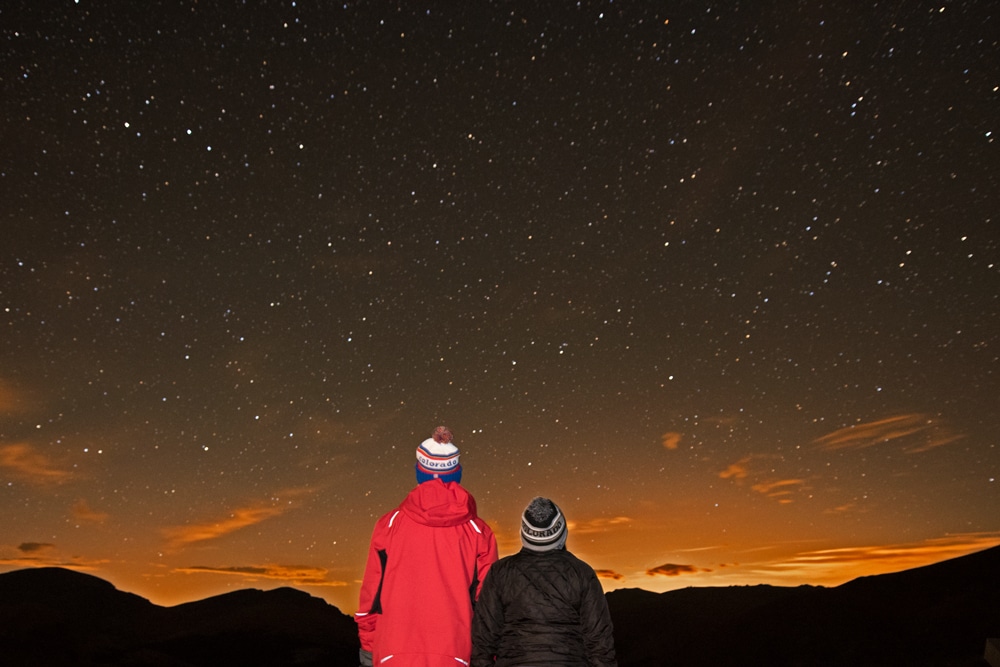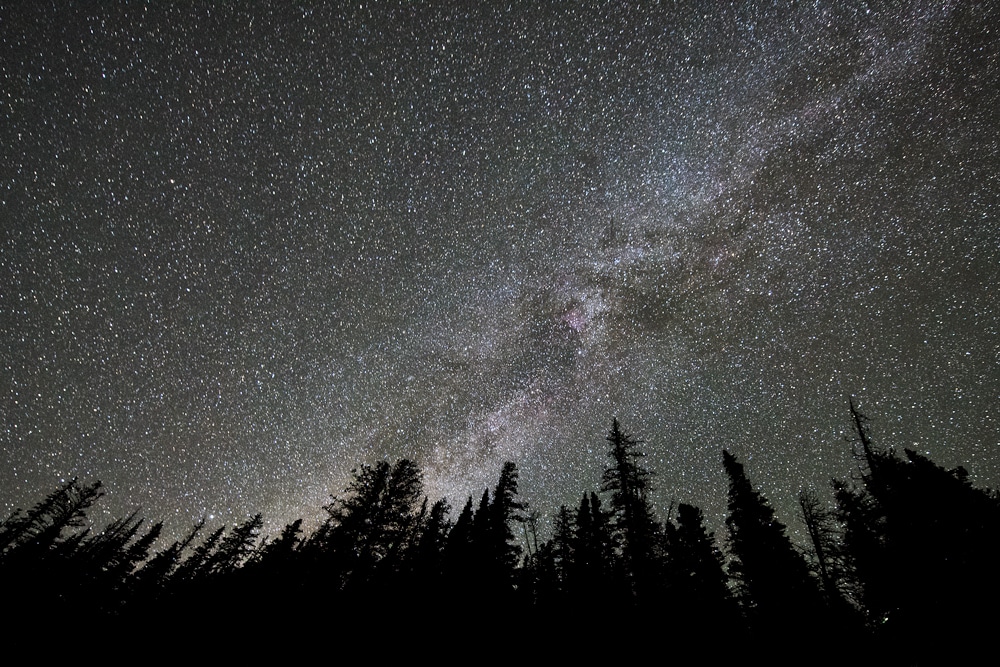Rocky Mountain National Park is brimming with epic beauty – from the mountains to the lakes, and of course the majestic wildlife. However, the beauty doesn't go away when the sun goes down. Stargazing in Rocky Mountain National Park at night is a breathtaking experience you are sure to cherish.

When to Go Stargazing in Rocky Mountain National Park
The best time for stargazing in Rocky Mountain National Park is during a new moon. When there is no light from the moon, even the baby stars seem to pop out of the black canvas of the night sky.
You can even see entire constellations and the unreal beauty of the Milky Way. Just check the lunar schedule before setting a date for your stargazing adventure!
Another thing to keep in mind is the weather. This can be difficult to plan around, especially in Colorado. But, going out on a clear night is definitely ideal when possible. You may also want to avoid going during extremely cold weather. Even in fall, RMNP can be quite chilly.
Many of the roads (including Trail Ridge) are closed in the winter and spring, even into summer. So, keep that in mind as well.

Where to Go to Stargze in Rocky Mountain National Park
Trail Ridge Road at Night
There are many amazing options for stargazing in Rocky Mountain National Park, but our absolute favorite is atop Trail Ridge Road. As mentioned previously, you will want to make sure this road is opened before your trip. And you should also drive it during the day to make sure you feel safe driving it at night.
There are no lights on the road and lots of sharp turns with drop-offs – which can be a dangerous combination if you are going too fast.

After a slow and careful drive up, park in one of the designated parking lots (DO NOT park in the road), turn off your lights and get ready to experience pure magic. When you get out of your car it will take your eyes a few seconds to adjust. But when they do, you are sure to let out a “Wooooow” or you may just be too awe-struck to speak!
We stood outside of our car shivering and enjoying our real-life planetarium for what felt like hours. We even saw a few shooting stars and got to hear some elk bugling! Of course, we also got some pretty amazing pictures, but nothing really compares to experiencing this overwhelming beauty in person.

Mountain Lakes – Poudre Lake
If you can't make it up to Trail Ridge Road, sitting by a mountain lake is another great option. This has the added bonus of getting to see the stars reflect off the water, too. We spent some time at Poudre Lake on the Grand Lake side of RMNP. And, we loved the peaceful calm of this area of the park in those early-morning hours.
However, being alone in the mountain wilderness at 2 a.m. can be a bit unnerving. Especially since you don't know what animal may be hanging out nearby. Just be aware of your surroundings and don't go too far from your car, and you should be fine.
It is also a good idea to scope out the area with a flashlight before finding your stargazing spot. How awkward would it be to ruin a bear's date night?

What to Bring for Star Gazing in the Mountains
- Warm Clothes: The mountains are often cold at night, regardless of the time of year. So, a jacket or blanket at minimum is a good idea. In the colder months, you will definitely want to really bundle up and bring some gloves along too!
- Flashlight: As previously mentioned, you'll definitely want to scope out your surroundings. So, a flashlight is key. Preferably not the one on your phone, since you probably don't want to be stuck with no battery on your phone in the mountains at midnight! Ideally, if you can get one with a red-light filter it is better for your night vision.
- Water & Snacks: Even if you are just going out for a little bit, always bring these essentials when out in the mountains. God-forbid your car battery dies and you get stuck out there overnight!
- A Full Tank of Gas: Especially if you are headed to Trail Ridge Road, you will probably use a decent amount of gas. So, make sure to fill up before this adventure!
- Camera & a Tripod: If you want to capture some awesome photos of your experience you will need a camera that allows you to manually control the settings and you will also need a way to keep it still. We love using our Sony A6300 for this type of photography. But, I'm sure you can look up tutorials based on what you have to work with!

Astrophotography Tips
Getting to experience this insane amount of stars in Rocky Mountain National Park at night is truly amazing. And you should definitely take time to experience it distraction-free. But, having a memento is also nice! So, here are three tips for snapping great star photos:
- Adjust your settings. A higher ISO (2500-3200) and long shutter speed is key for astrophotography. For our photos, my hubby had his camera set to about a 30-second shutter speed and adjusted ISO accordingly until the picture looked right.
- Use a tripod. If your camera is moving all over the place, your photos will never turn out. A good tripod is definitely necessary.
- Use a remote shutter or timer. To minimize movement of your camera when hitting the shutter release, you can use a remote for the shutter, or just set the photo to take 5 seconds after shutter release.
- Stay patient. It may take a few tries before you get your settings right, but just keep at it. But, if you are getting too frustrated don't let it ruin this experience for you. Despite what the entire world of social-media lovers seems to think, you don't have to have a photo to prove you had fun!
Want more tips for Rocky Mountain National Park? Read more:
- 3 Short Hikes in Rocky Mountain National Park
- Alberta Falls, The Loch & Snow Sliding
- Easy Winter Hike: Bierstadt Lake
- 3 Easy Snow Hikes in RMNP
- Weekend Getaway Guide: Grand Lake
For more great Colorado hikes and activities for every season, check out our Colorado page.





